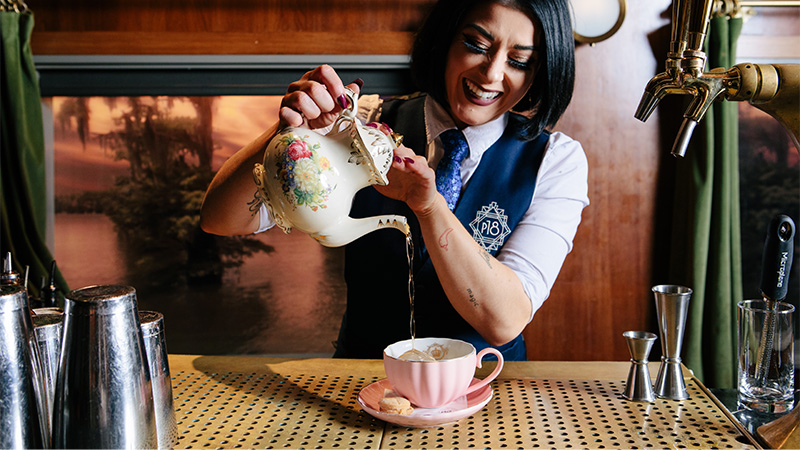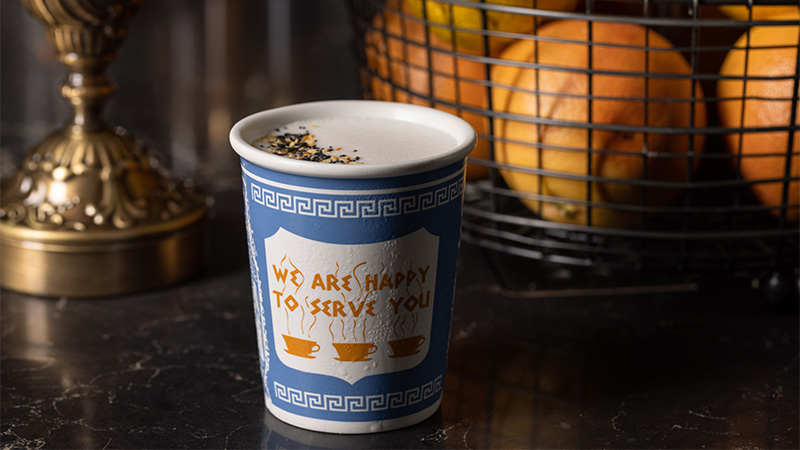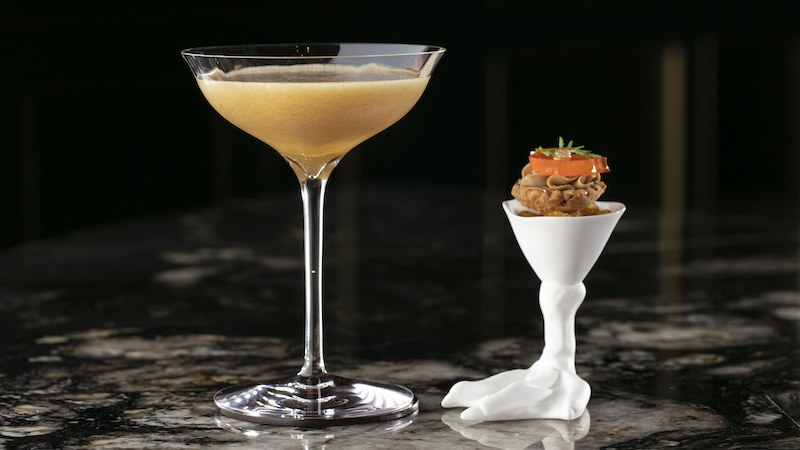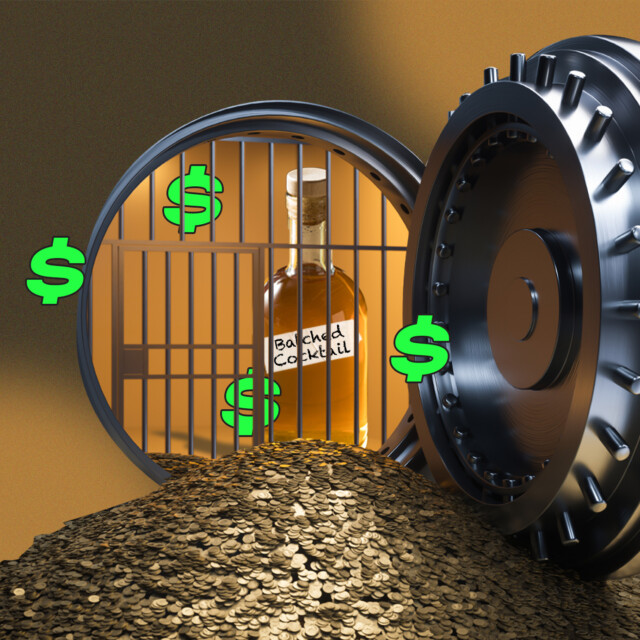In 2019, pre-batched cocktails were gaining ground, with even some of the world’s most renowned cocktail bars diving head first into the concept. The sudden spike in interest for pre-batched drinks seemed to sprout from a desire for consistency, and marked the culmination of several labor-intensive trends like fat washing, house infusions, and force-carbonating cocktails, which all require time and a certain level of behind-the-scenes work. Just as people were starting to come around to the idea that drinks made hours or days before they ordered them could be just as — if not more — interesting than the cocktails they were used to, the pandemic changed the entire dynamic of drinking.
While batched drinks provided a necessary lifeline for bars in the “to-go” era of the pandemic, after months of at-home bartending and canned drinks in the park, bar-goers were eager to return to their favorite haunts and enjoy the hospitality and theater they recalled from the days of in-person dining.
So imagine the contradiction of finally walking into a high-end cocktail bar, ready to be entertained, and ordering the most elaborate cocktail on the menu — only to be met with a small bottle of liquid deftly poured into your glass. Was that it? A mere transfer between glass vessels?
Perhaps you experienced it for yourself. And when the check arrived, you contemplated whether or not the pricey cocktail was significantly better than an at-home freezer Martini or ready-to-drink Margaritas after all.
If the pandemic taught us one thing about drinking it’s that what’s inside the glass isn’t necessarily the main draw for visiting bars. We want to be taken care of — we seek the thrill and entertainment of watching experiences unfold in front of our eyes. Meanwhile, bars are navigating shortages of skilled staff and an increasingly knowledgeable audience seeking intricate cocktails and over-the-top experiences. This is leading more bars and restaurants to prefer the pre-batched system — often putting consumers and establishments at odds.
As cocktail prices around the country soar toward — and upwards of — the $20 line, can those same bars convince consumers that their meticulously pre-batched concoctions are worthy of the hefty price tag?
Don’t Drink the Punch
Most bars that grace the World’s 50 Best List use the method on some level, and a growing number of respected bars and restaurants across the country are following suit including New York’s Forsythia, Corrida in Boulder, Colo., and Indienne in Chicago. Yet, for many, the technique recalls more humble, rudimentary beginnings. “It harks back to college days, so there’s still that stigma,” says Sarah Karges, a New York City- based digital marketer. “We learned to avoid the punch by the end.”
Beyond house party jungle juice, many drinkers are accustomed to seeing pre-batched drinks at catered events or high-volume restaurants, which seem to have cemented the batched cocktail’s reputation as a product made for quantity, not quality. “At some bars or restaurants I wouldn’t even notice if the cocktails are pre-batched,” Karges says. “But if I am going to a place that is known for their cocktails, I would expect them to make them on the spot. You want to see that the bartenders know what they are doing, and you also want the full experience.”
More Than Meets the Eye
One of the greatest misconceptions that many have about pre-batched drinks is that they require little to no effort. “When I go to a cocktail bar and see options that are pre-batched or on draft I will never order [them]. I think the bar needs to put in the energy to make the drink fresh. Especially now that they are so expensive,” says AiLinh, a New York-based events director for People Magazine. When AiLinh encounters pre-batched cocktails at bars, she admits, “I kind of feel like I got jipped.”
So, if a certain slice of the population remains so hesitant about pre-batched drinks, why are craft cocktail bars and restaurants going all-in on the concept?
“I have always worked at busier bars where you have to batch cocktails or they will take 20 to 30 minutes to make and the bar will get backed up. There is nothing you lose by batching cocktails, outside of maybe a little bit of showmanship.”
Many cite pre-batching as a way to ensure consistency and efficiency behind the bar. Jonathan Adler, the beverage director for New York’s Michelin-starred Noda and its neighboring cocktail bar Shinji’s, notes that pre-batching cocktails allows the bartenders to have more time to focus on service and hospitality as well as provide a level of uniformity. “If you do the work ahead of time, when you aren’t in the heat of service with accumulating pressure, then the consistency of the drinks is going to be a lot higher,” Adler says. “The most important thing is the taste of the drink. If you can ensure that the flavor is consistent every time, guests should appreciate that.”
At Mace, a Manhattan bar focusing on spice-inspired cocktails, most of the components for drinks are pre-batched, allowing the bar team to assemble multiple different elements quickly. “Setting it up so all of our cocktails are ideally just three-bottle pickups as opposed to touching 10 bottles is crazy important at Mace,” says head bartender Emily Hosler.
On pre-batched drinks in general, Hosler adds: “It depends on the type of bar. I have always worked at busier bars where you have to batch cocktails or they will take 20 to 30 minutes to make and the bar will get backed up. There is nothing you lose by batching cocktails, outside of maybe a little bit of showmanship.”
In line with this, larger bars like Miami’s Sweet Liberty, which has a capacity of around 300 people, or bars with extensive menus like Platform 18, which offers over 40 different craft cocktails in Phoenix, find pre-batching necessary to keep up with the high volume of different orders.
“It is now the norm for craft cocktail bars to use modern technology like centrifuges, rotary evaporators, and a million other contraptions that help you make the best drink possible.”
Contrary to the opinion that they take less work, pre-batched drinks generally require more time than the typical cocktail, with some taking days of labor to achieve the desired flavor profile. The menu at Platform 18 takes 140 hours of prep work per week, and the most elaborate cocktail at Mace takes about five days of constant infusing and straining.

Beyond efficiency, pre-batching cocktails gives bar programs a little more room for creativity and experimentation. Phoenix-based Jason Asher, founding partner of Barter & Shake Cocktail Entertainment and VP of Beverage at Platform 18, Grey Hen Rx, and UnderTow, says that pre-batched drinks are rising in popularity among the world’s most prestigious bars due to the availability of new technologies.
“It is now the norm for craft cocktail bars to use modern technology like centrifuges, rotary evaporators, and a million other contraptions that help you make the best drink possible,” Asher says. With the advent of these new techniques, standards have risen to expect the best bars to employ as many impressive processes as possible — making it near impossible for a top cocktail bar to design a menu without pre-batching in mind.
The only sticking point: Such preparations typically take place behind the scenes and before service — beyond the gaze of guests.
Putting on a Show
Whether or not a second “Roaring Twenties” truly materialized when the pandemic subsided, as many had hoped, guests returned to bars seeking to be wowed. Tableside service flourished — Martinis arrived accompanied by the accessible decadence of caviar bumps. In this revamped bar scene, receiving a drink where all the work has already been done can leave many feeling short-changed.
Bars including Mace, Sweet Liberty, and Platform 18 address this by pre-batching as many components of the drinks as possible, without pre-diluting, which simplifies the drink’s build as opposed to doing away with mixing entirely. This way, guests still witness stirring or shaking at the bar.

At bars where the drinks are pre-diluted and chilled, more elaborate techniques are employed. Shinji’s offers stunning presentations including the impressive Tropicana cocktail, which comes in a hollowed-out, blast-frozen orange, as well as surprising drink components like the Foie Gras Sidecar cocktail, which is made with Hennessy X.O that has been fat-washed with foie gras and cocoa butter and does, indeed, come with a delicately plated foie gras tartlet.
As it turns out, even those who are doubtful about pre-batched drinks can be won over with a good show. “Shinji’s goes the extra mile with the theatrical cocktail experience,” admits batching-skeptic AiLinh.

Similarly, other thoughtful cocktail bars that have partially or entirely pre-batched programs make the cocktails as visually appealing as possible, in hopes that it will shift the guest’s attitude toward these drinks.
Madame George, a subterranean speakeasy-style bar in New York City, pre-batches some elements of its menu but makes up for it with elaborate drink presentations including the NY Bodega Sour, served in a ceramic version of a classic bodega coffee cup. “We are aware that a batched cocktail may take a little bit of the magic away from the guests perception, but the hours and hard work are simply done before they walk through the door,” says beverage director Marshall Minaya. Even so, Minaya stands by the pre-batched drink as the ultimate sign of hospitality, and says there’s “no better way to show hospitality than a punch, as we are proving our constant goal of pleasing and hosting our guests even before they decide to come to our bar.”
